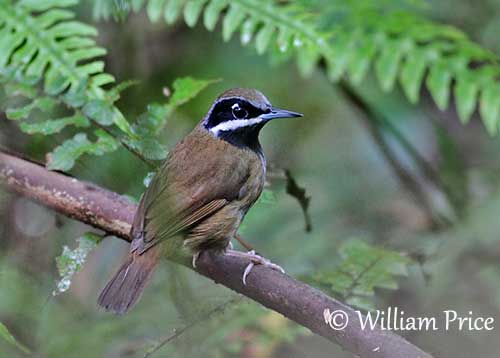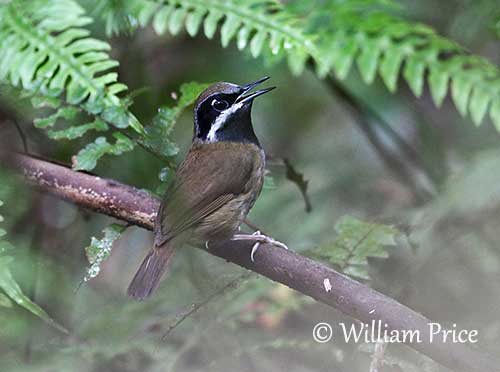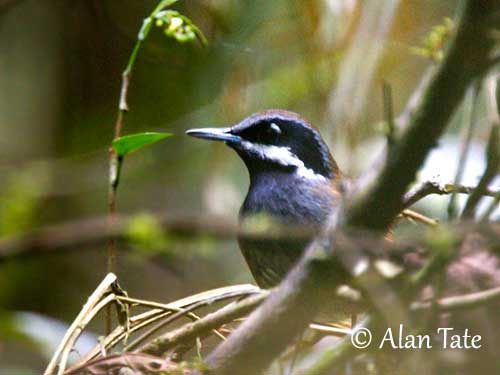
Fr: Mystacorne de Crossley
Ang: Crossley's Vanga - Crossley's Babbler - Madagascar Groundhunter
All: Crossleytimalie
Esp: Tordina Malgache
Ita: Garrulo di Crossley
Nd: Crossleys Timalia
Sd: markvanga
Mal: mokazavonamavo, Sohohitrala, Soratrala, Talapiotany
Photographers:
William Price
PBase-tereksandpiper & Flickr William Price
Alan & Ann Tate
AA Bird Photography
Text by Nicole Bouglouan
Sources :
HANDBOOK OF THE BIRDS OF THE WORLD Vol 14 by Josep del Hoyo-Andrew Elliot-David Christie - Lynx Edicions – ISBN: 9788496553507
Birds of Madagascar: A Photographic Guide Par Pete Morris, Frank Hawkins – ISBN: 0300077556, 9780300077551- Editeur: Yale University Press, 1998
Birds of Madagascar and the Indian Ocean Islands Par Roger Safford, Adrian Skerrett, Frank Hawkins – ISBN: 1472924118, 9781472924117- Editeur: Bloomsbury Publishing, 2015
Wildlife of Madagascar par Ken Behrens, Keith Barnes - ISBN: 140088067X, 9781400880676 – Editeur: Princeton University Press, 2016
Creagus – Bird Families of the World – Vangas - Vanginae
THE VANGAS OF MADAGASCAR by Nick Garbutt
Crossley’s Vanga
Mystacornis crossleyi
Passeriformes Order – Vangidae Family
INTRODUCTION:
The Crossley’s Vanga is endemic to Madagascar where it frequents the eastern rainforest, usually below 1,300 metres of elevation.
It was formerly named “Madagascar Groundhunter” and this name describes very well the foraging behaviour of this terrestrial species that gleans invertebrates from the ground.
The Crossley’s Vanga depends on suitable forest habitats, but it is not currently threatened.
DESCRIPTION OF THE BIRD:
Biometrics:
Length: 15-16 cm
Weight: 21-28 g
The Crossley’s Vanga adult male has olive-brown upperparts with paler wing flash. The tail is brown with rufous tinge.
On the underparts, chin, throat and upper breast are blackish, becoming grey on breast. Belly and vent are mostly greyish-white, whereas flanks and outer undertail-coverts are dull ochrous-olive.
On the head, the crown is grey with bluish-grey wash on sides and nape. There is sometimes a bluish-grey sheen overall, depending on the light. The area from lores to above the eye is black, while upper ear-coverts are glossy blackish-blue, and lower ear-coverts are black. We can see a conspicuous white submoustachial stripe extending to neck-sides. There is a white spot on the top of the eyering.
The long, slightly hooked-tipped bill has black upper mandible and pale bluish-grey lower mandible with black tip. The eyes are dark brown. Legs and feet are pinkish.

The female resembles male but she has the crown like the upperparts. The tail is duller. Lores, supercilium and upper ear-coverts are pale grey. We can see a black stripe from eye to side of nape.
On the underparts, chin, throat and breast are white (not blackish) with pale grey wash on breast.
The juvenile resembles female but it has chestnut head and neck, black eye stripe and rufous upperparts, whereas throat and underparts are pale chestnut. Centre of breast and belly is white.
RANGE:
The Crossley’s Vanga is found in NW and E Madagascar.
HABITAT:
The Crossley’s Vanga occurs from sea-level up to 1,800 metres of elevation in the humid primary evergreen forest in the east of the island. It is usually seen below 1,300 metres.
CALLS AND SONGS: SOUNDS BY XENO-CANTO
The Crossley’s Vanga gives very high-pitched “peeer” and a loud shaking in alarm.
The song is a loud, clear whistle of about two seconds, similar to that of the Hook-billed Vanga but more modulated “tsiiioeeeeee” falling and rising slightly. We can also hear a series of single-note whistles, sometimes given in rising series “tooee tooee tooee”.

BEHAVIOUR IN THE WILD:
The Crossley’s Vanga feeds on small invertebrates, mostly insects such as Blattodea, Dermaptera, Hemipterans, Orthoptera and Formicidae, and also spiders of family Salticidae.
This species is mostly terrestrial and forages by walking or running, but it rarely flies. While walking, it bobs the head backwards and forwards.
It can be seen alone or in pairs, searching for prey in open understorey or among the leaf litter. It also probes mosses and epiphytes with the bill, often near rotten trees and fallen trunks.
It is difficult to find when silent.
During the breeding season, the male is aggressive and does not tolerate other males. Both mates display by circling each other with their tails cocked up. They are monogamous.
The Crossley’s Vanga is resident on Madagascar. It rarely flies, preferring to walk around on the ground.

REPRODUCTION OF THIS SPECIES:
The breeding season occurs between August and November.
The Crossley’s Vanga male builds the nest, a shallow cup-shaped structure or a platform made with twigs and sometimes fine black rootlets. The nest is placed in small tree between 1 and 5 metres above the ground, but also in horizontal vines or at base of crown of tree-fern.
The female lays 2-3 white eggs with chestnut mottling. Both adults share the incubation.
PROTECTION / THREATS / STATUS:
The Crossley’s Vanga is relatively common throughout its range, although being patchily distributed.
The species depends on forest conservation, but it is present in several protected areas and it is not globally threatened.
The Crossley’s Vanga is currently evaluated as Least Concern.